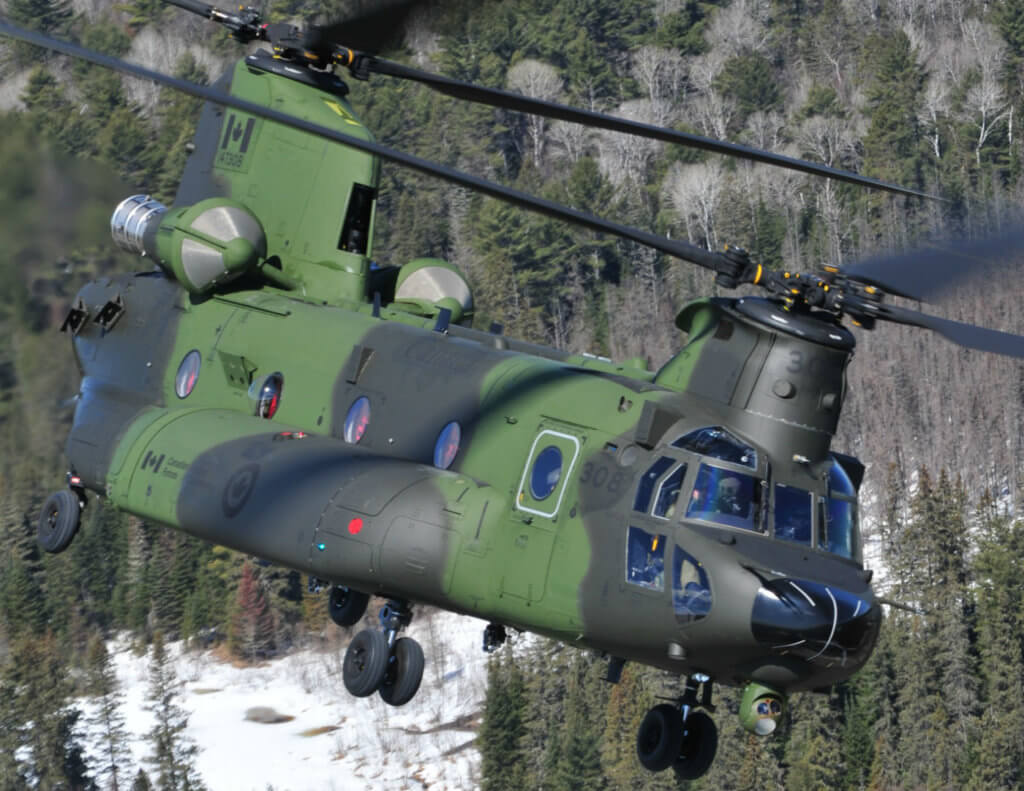Estimated reading time 6 minutes, 23 seconds.
In a manufacturing facility in Philadelphia, beside the steady activity of a production line building CH-47F Chinook helicopters at a rate of four to five a month for the United States Army, sits a line of empty scaffolding that between June 2013 and June 2014 produced 15 helicopters for the Royal Canadian Air Force (RCAF).

The line is primarily dedicated to special builds, derivatives of the standard F model that require unique features. And that was certainly the case for the Canadian CH-147F, which according to Boeing Defense, Space & Security “revolutionized” the F-model.
The RCAF requested 30 modifications to the U.S. Army variant, including extended range “fat tanks” that increased the flying time by about five hours and doubled its range; a digital automatic flight control system that enhanced situational awareness and automated aspects of landing in degraded visual environments; an additional electrical system; and an advanced directed infrared countermeasures suite.
Though it has been less than four years since the first Canadian CH-147F took flight, Boeing would like to see those birds back on the line should the RCAF decide to upgrade some of its capabilities.
While an upgrade program so soon into the operational service life of the fleet might seem hasty–in fact, the RCAF won’t declare the Chinooks fully operational until June 2018 after the defensive electronic warfare suite has been implemented–continuously refreshing technology as it evolves rather than waiting for one large midlife upgrade is part of a changing sustainment model for some fleets. The air force recently completed a significant block upgrade on its 17 CC-130J Hercules that only entered service between 2010 and 2012.
LGen Mike Hood, RCAF commander, told an aerospace audience in April that a block upgrade approach is how the air force aims to stay current with technology and implement design changes across its fleets. “That is how most of our fleets will continue to be postured,” he said. “We will continue to upgrade them in blocks along with our allies that are flying those aircraft. It is certainly a change in our operating concept since I started flying in the late ’80s.”
At present, the RCAF does not have an approved project to upgrade the CH-147F Chinooks, but it is seeking to improve the weapons system through the normal project approval process to “maintain relevance and compliance,” said a spokesperson.
However, National Defence and Public Services and Procurement Canada are in negotiations with Boeing for the second tranche, known as Pricing Period 2, of a 20-year performance-based logistics contract to deliver in-service support (ISS) to the CH-147F fleet.
The ISS contract, which includes sustainment of the fleet and training of the maintenance technicians, as well as expeditionary logistics support, began when the first Chinook arrived at 450 Tactical Helicopter Squadron in Petawawa, Ont., in 2013. It is based on the performance and flying hours of the fleet, what Richard Comtois, Boeing’s lead for integrated logistics systems on the program, called “power by the hour.”
The contract is also subject to renewal every five years. With the first tranche expiring on March 31, 2018, the company is “in the middle of [responding to] a request for proposal” for a second tranche,” said Comtois, a former CF-188 fighter pilot.
“We need to [constantly] prove ourselves,” he said of the Boeing team in Petawawa that includes suppliers such as L3 MAS, Raytheon, L3 Electronic System Services, and General Dynamics Mission Systems Canada. Since renewal is not guaranteed, “we feel that if we don’t perform, the government can walk away from the next tranche of in-service support.”
The 20-year overarching agreement, however, provides plenty of incentive to think beyond short-term transactions and invest in longer-term innovation, he added.
That is clearly in the interests of both the RCAF and Boeing. The first heavy-lift CH-47 Chinook left the Philadelphia factory over 50 years ago, and Boeing fully expects the platform to continue flying for another 50 years.
The company is in the middle of a demonstrator program for the U.S. Army’s medium-sized Future Vertical Lift, but “there is nothing on the drawing board for heavy lift helicopter today,” said Ed Hassiepen, who is responsible for Chinook business development in the Asia Pacific. “That is why the U.S. Army is going to do a refresh in the 2020s and probably another in the 2030s to 2040s to get these [aircraft] out to 2060.”
Over 850 Chinooks are in service or on order with 19 customers, including 244 of a possible 450 with the U.S. Army. And that number is likely to grow. The CH-47F has been shortlisted by the German armed forces in a heavy-lift helicopter replacement program and Boeing is pursuing competitions in Poland and Southeast Asia.
“We are constantly seeing additional demand,” said David Koopersmith, vice president and general manager of the vertical lift division. The company is also developing a Block 2 configuration for the 2020 timeframe.
The RCAF’s continuous upgrade approach also fits with Boeing’s business model of iterative innovation, part of which involves building new capability into existing platforms. Whether it is advances in rotor blades or many of the technologies that Canada introduced into the aircraft, Koopersmith said “all of those things I see as future capabilities to enhance.”








